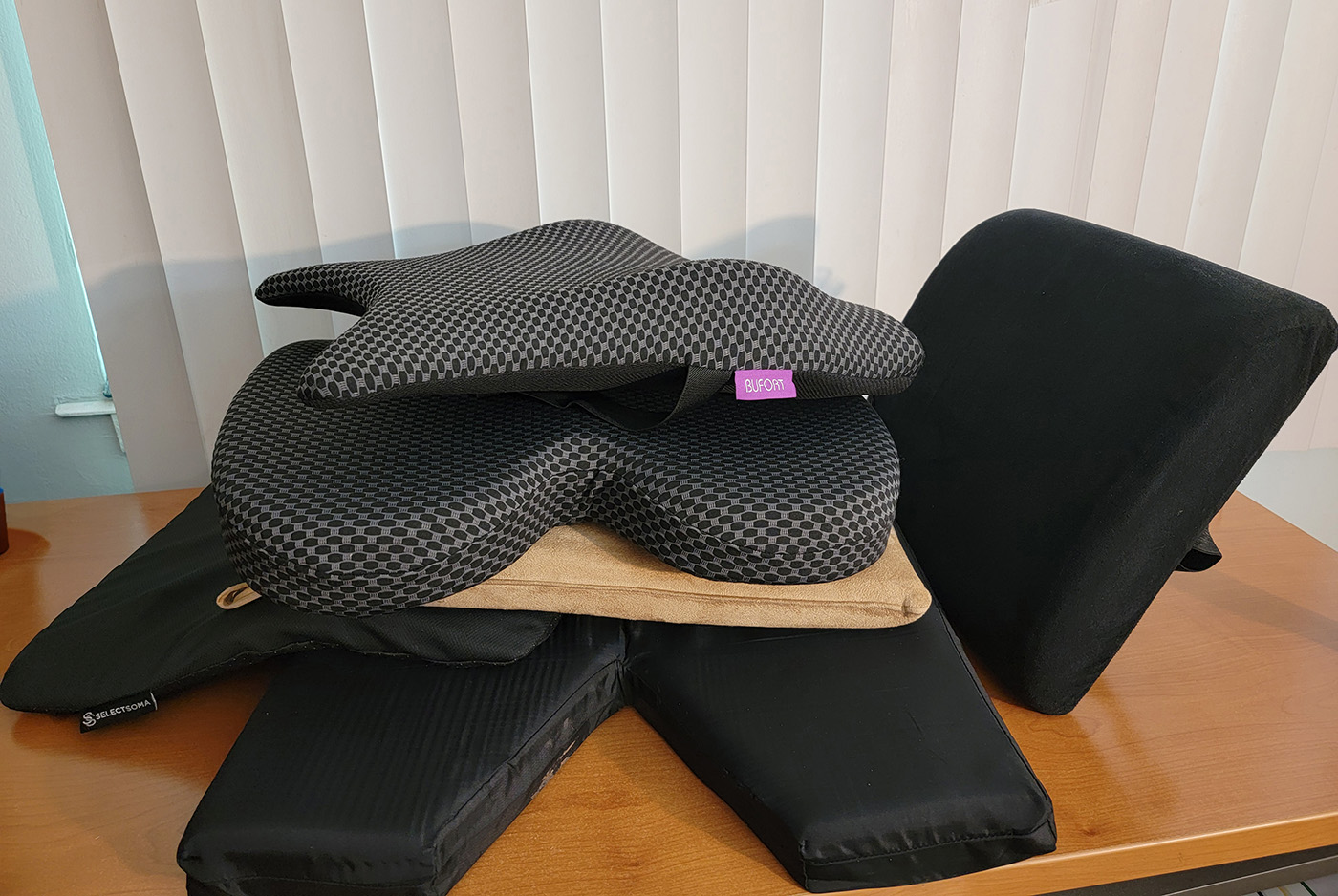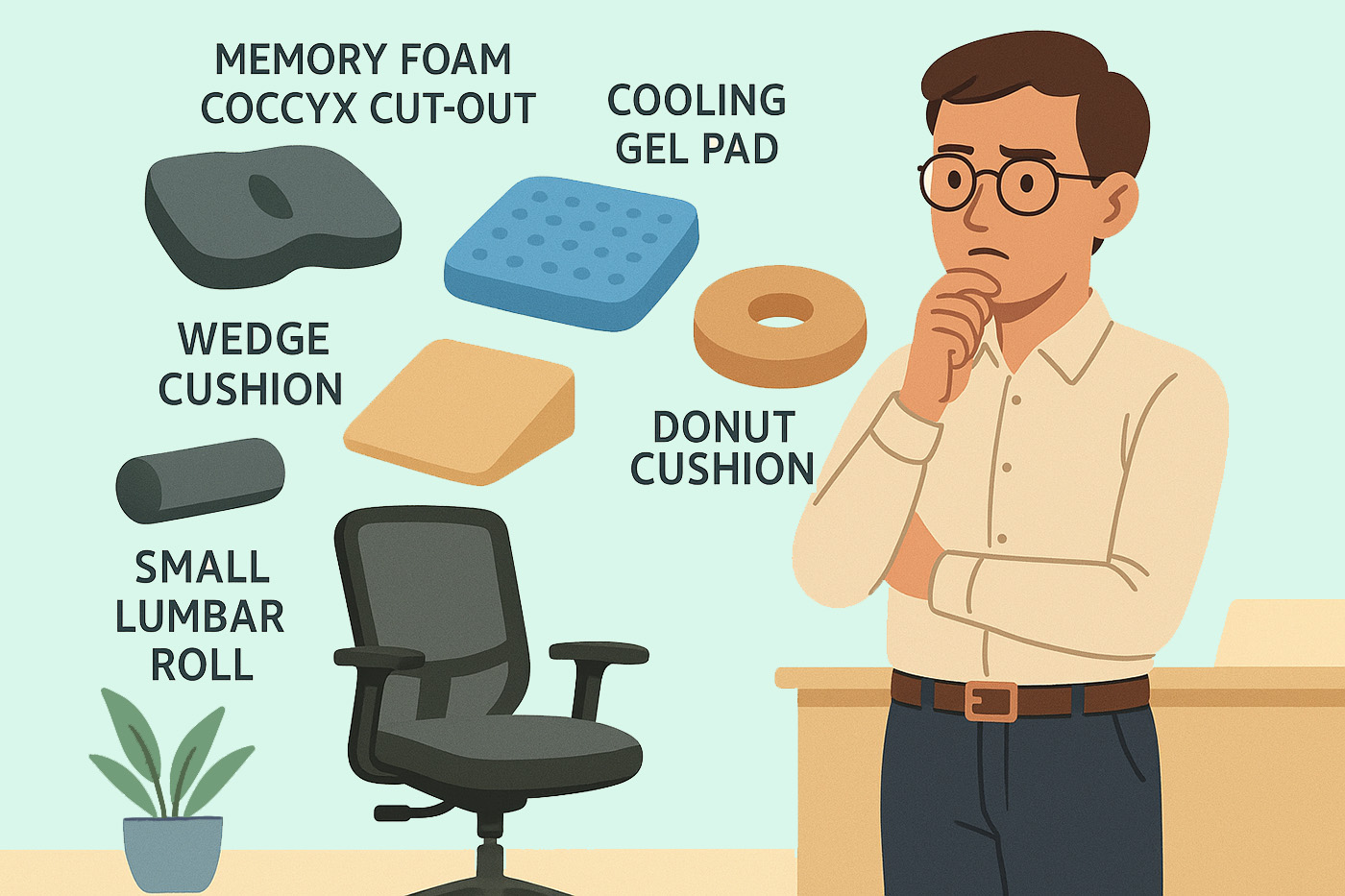Does your back, hip, or butt start to hurt after you’ve been sitting at work for while? Depending on your seating and work environment, using a seat cushion or lumbar support cushion can help relieve the pain. However, as I’ve discovered the hard way, choosing the best office chair cushion can be a real pain. Here’s why.
Confusing Array of Office Chair Cushion Choices
Comfortable, ergonomic seating is essential—so it’s no surprise that dozens of companies make a wide variety of lumbar support pillows and seat cushions for office chairs and other seating. These products target different parts of the body and are designed for different types of chairs. But there are so many that finding the best chair cushion and support for you can be a royal pain.
As a writer, I spend a lot of time sitting in an office chair in front of my computer. Over the years—as you can see from this photo—I’ve bought several different types of seat cushions to provide comfort and relieve tailbone and back pain.

Some only worked for a short time. Two cushions that didn’t work very well in my office got repurposed for use on furniture in our den. In addition to the cushions in the photo, there were two I bought and immediately returned because they were too hard and uncomfortable to sit on.
This page contains one or more affiliate links from which we may make a commission if you make a purchase through the link. Learn more.
What’s the Best Office Chair Support Cushion?
In my opinion, there is no one best office chair cushion for every person. Factors such as your height, your weight, the type of chair you’re using in your office, and your personal preferences all come into play.
The product that has worked best for me is an inexpensive, two-piece Bufort memory foam seat cushion and lumbar support set. I bought it in 2023. It still provides the comfort, support, and pain relief I need.
What I like about this desk chair support set is that it has the right amount of cushioning and support for me. It’s not too hard or too soft. And I can choose (depending on what’s hurting me) whether to use both the seat cushion and the lumbar back support or just one of the pieces.
The lumbar support pillow has an elastic band on it that lets me slide it onto the chair and helps hold it in place. The pillow is longer than many lumbar support pillows, and I believe that helps my upper back as well as my lower back.
The seat cushion is ergonomically designed. It’s slightly u-shaped with slight indentations where the top of your legs sit. The design helps relieve coccyx pressure, provides support for my hips, and takes pressure off the back of my thighs. It has a textured, non-slip bottom that helps keep the seat cushion in place on my chair.
Because of the thickness of the cushion, I find I have to lower my office chair height slightly to keep the tops of my legs from scraping against the underside of my desk keyboard tray.
Both the lumbar support pillow and seat cushion have covers that can be removed for washing.
Related: Best wrist rest support when you work at a desk
How to Find the Best Desk Chair Support Cushions for Your Back
If you have ongoing back, hip, neck, or butt pain, be sure to see a doctor to have your condition properly diagnosed. While you’re there, ask the doctor what type of office chair support cushion they would suggest to help relieve your pain.
Among the possibilities:
Lumbar support cushions
These cushions help support your lower back. Some are just small cushions that fit between the curve in your lower back and your chair. Others are longer, S-shaped pillows that follow the natural curve of the lower and upper back. Lumbar support pillows help relieve pain by helping you maintain good posture and reducing the strain on the discs and muscles in your back.
Desk seat cushions
Seat cushions that are ergonomically designed distribute your weight more evenly, relieving pressure on your hips, your tailbone, and the backs of your thighs. Furthermore, the padding can make it more comfortable to sit for extended periods of time on a chair with little padding or one with worn-out padding.
- S-shaped and U-shaped cushions. These types of seat cushions have features that cradle your bottom and help support your hips and lower spine. They have cutouts or depressions that help relieve pressure on the spine and legs and alleviate and reduce lower back pain when you sit for prolonged periods of time.
- Donut hole cushions, also called coccyx cushions, have an opening that can help relieve pain by taking the pressure off your tailbone. They resemble an oversized donut or the swimming tubes children use in the summer.
- Wedge cushions are another type of cushion designed to help you sit properly by tilting your body slightly forward.
Related: Footrests are inexpensive ergonomic additions
Office Cushion Specifications that Matter
In addition to the type of support you need, there are other factors to consider when you buy desk chair cushions.
Gel or Memory Foam Cushioning
You can find gel seat cushions (no memory foam), memory foam seat cushions, and gel-infused seat cushions. The best depends partly on personal preference. In general:
- Memory foam provides good support, and it contours to your body.
- Gel-infused memory foam cushions are cooler to the touch than memory foam but tend to be firmer to sit on.
- Gel cushions that don’t include memory foam are advertised as being soft and breathable. They may be good for some people, but I found the honeycombed gel cushion I bought was too soft and wobbly for me.
Physical Dimensions of the Chair and Cushion
The length, width, depth and height of the cushion need to be appropriate for your office chair. It’s unlikely that you’ll find a perfect match for the dimensions of your desk chair, but cushions that are larger than the chair won’t fit.
Your Height and Weight
Your height and weight can play a role in determining the correct support pillows to get. A shorter, lighter-weight person is likely to have different firmness, thickness and support needs than taller and heavier individuals. Examine the manufacturer’s specifications to determine the range of body weights they have designed their products for. Check product reviews as well.
Firmness of the Cushioning Material
Cushions come in various degrees of firmness. Some may be too firm for you, others too soft. Read customer reviews of desk chair cushions to see if firmness is mentioned.
Stays in Place
Read the product description and reviews to be sure the cushion has some type of feature that helps it stay in place when you get up or move around in your chair. Elastic straps are helpful on a lumbar support pillow, and non-skid rubber backing works best on chair seat cushions.
Washability
Look for office support cushions that have removable, washable covers.
How to Make the Right Choice
Finding the best office chair support cushioning for you can be somewhat of a hit-or-miss effort. Among the reasons, you may not be able to find a brick-and-mortar store to evaluate your choice.
So, start by listing identifiable factors such as the type of pain you are having, your body type and weight, the type of chair you sit in, and the physical dimensions of your chair.
Then, search online for the type of cushion for your office chair (seat cushion, lumbar support, or both) that you want. Look for vendors that offer free shipping and returns. (I used Amazon Prime.)
Review the product specifications for the various types of cushions that seem appropriate for your needs. That information may be in a visible description, or you may find it under a heading like “See more product details” or “Specifications.”
Read customer reviews. On Amazon, I like to look at the number of top ratings compared to the number of lower ratings. Then I browse through the both the top ratings and the low ratings to see what people like and if there are any trends in complaints. (In some cases, Amazon provides that summary when you open the reviews section.)
Try Without Losing Money
You may need to order a couple of different support cushions before you find the best one for you. So before you place your order, check to see that the vendor offers free shipping and that you won’t be charged to ship the product back if you need to return it.
